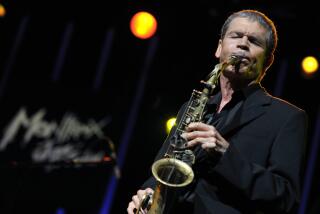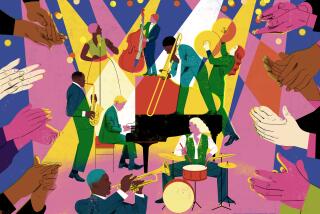JAZZ REVIEW : Imitable David Sanborn Lights Musical Fireworks
- Share via
Everywhere you look these days you find David Sanborn. He co-hosts NBC’s “Sunday Night,” which brings jazz and R&B; to late-night television. He has his own radio program, “The Jazz Show With David Sanborn” (that sadly isn’t carried in Los Angeles, but is aired in San Diego). And, in addition to his recordings, he’s made recent guest appearances on albums from performers ranging from Eddie Palmieri to Brenda Russell.
Even more prevalent is the Sanborn sound, which has become the model for a generation of jazz-fusion alto saxophonists. Though the man modestly claims that he’s not an innovator, his easily identifiable hard-edged tone and emotional way with a solo have been copied by so many musicians that it’s no longer safe to identify an unseen alto player as Sanborn just because he has the Sanborn sound.
The man could be found Tuesday night at the Pacific Amphitheatre, and with so many imitators out there, it was good to see the original. His five-piece band was tight as a new shoe and, led by bassist Tom Barney, played with a tougher sound than heard on the saxophonist’s recent albums. The material the group performed, much of it composed by Miles Davis collaborator Marcus Miller, played to Sanborn’s strengths. Funky, R&B-influenced; themes allowed the saxophonist to climb the scales with excitement before setting off the fireworks.
The set opened with Sanborn quoting from Thelonious Monk’s “Well You Needn’t” as the band broke into the slightly sinister groove of “Run for Cover.” Looking imperially slim in a blue sport coat and pants, the saxophonist got down to what he does best, building his solo quickly out of the middle range before spilling his soul in the high end. There was little subtlety in his playing, with quick, agile lines leading to a squealing climax.
The pattern continued with what is now a Sanborn standard entitled “Straight to the Heart,” a tune that began at a ballad pace and built into a moving, emotional statement. The strong feelings of Miller’s “Blue Beach,” which featured a heated exchange between drummer Sonny Emory and percussionist Don Alias, spilled out into the audience. (One overzealous fan’s expressive, barely-in-control dancing at his seat led to scuffles with surrounding patrons and more scuffling with security, resulting in his ejection from the theater.)
Sanborn varied the pace with “As We Speak” and his own (in conjunction with Michael Ruff) “Lesley Ann,” both numbers giving him a chance to show a thoughtful, more sensitive side. On the latter, guitarist Robben Ford followed Sanborn’s earlier example, constructing his bluesy solo with chordal pops and runs to the high end.
The night’s best moments came during King Curtis’ “Soul Serenade,” a perfect vehicle for Sanborn’s R&B; sensibilities. Keyboardist Ricky Peterson switched to organ for the tune, filling his solo with the kind of excitement that the late Larry Young brought to the instrument. Ford demonstrated his own slow-hand style before trading furious fours with the saxophonist.
The band’s scorching encore, “Summer,” featured Barney’s thumb-heavy bass solo and an excursion from Sanborn that was much like the man himself: Busy.
Opening the show was singer Brenda Russell. Russell utilizes a smooth, even delivery and doesn’t rely on flash or stylistic antics to get her point across. She also composes most of her own music, and songs like “This Time I Need You”and “Waiting for You” showed she hasa varied sense of rhythm and a good ear for melody.
Less successful were the tunes “Stupid Love” and “All American” which were pleasantly musical but crippled by inane lyrics. Her rendition of “Get Here,” the title number from her last album, contained a number of dramatic pauses and allowed her to show some range and a pleasingly sensual growl.
More to Read
The complete guide to home viewing
Get Screen Gab for everything about the TV shows and streaming movies everyone’s talking about.
You may occasionally receive promotional content from the Los Angeles Times.






